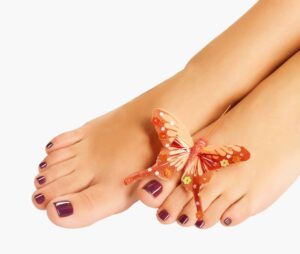Fake Toenail
Fake Toenail

KeryFlex Nail Restoration is a painless, in-office procedure that restores the appearance of natural nails. Your certified provider remodels the damaged nails affected by fungus, and defects due to trauma. The composite resin Fake Toenail creates a flexible, durable, and non-porous nail which allows the remaining natural nail to grow. This cosmetic procedure is unaffected by acetone, nail polishes, and detergents.
This Nail Restoration should be used on individuals with peripheral vascular disease, arterial insufficiency, peripheral neuropathy, suspicious pigmented lesions on the nail or in-grown toenails. It should be avoided in patients who are pregnant, nursing or known to be sensitive or allergic to any of its ingredients
Why KeryFlex Fake Toenail ?
- Another option for patients with damaged nails
- Provides immediate enhancement after one visit
- Natural look and feel
- Available in 3 colors: clear, natural, and opaque
- Unaffected by acetone or other nail polishes
- Applied in a foot care setting
- Non-porous, which will allow moisture to penetrate between the natural and prosthetic nail.
- Remaining nail can grow out naturally
- Does not irritate human tissue
- Restored nails are flexible to our natural movement patterns
Keryflex is a cosmetic procedure used on patients with mild or moderate impairment caused by:
- Nail fungus
- Nail shape changes due to injury
- Spoon shaped nails
- Brittle and splitting nails
- Horizontal ridges
- Discolored nails
What should I Expect?
Your foot care provider will determine if the Keryflex treatment is right for you, and the damaged nail will be trimmed/filed down as much as needed. Nail clippers and electric files may be used to prepare the nail. Restoration of the nail begins by applying a bonding agent, followed by resin. The material is then hardened with UV light and molded. The nail is smoothed and shaped, and finally a sealant is applied and cured with light once again. The procedure can be completed in 30 minutes or less depending on the condition of the nail.
These suggestions can make it safer for you to enjoy artificial nails if you adore their appearance.
Avoid fake nails if you’ve ever had nail fungus. Don’t use them to hide issues with your nails.
Instead of filing your nails, get ones that can be soaked off.
Request that your manicurist avoid overly cutting or pushing back the cuticles. They serve as an infection defense.
Artificial nail side effects you should be careful about
Artificial nails may be beautiful, but they also have some drawbacks. The following are some of the drawbacks of using artificial nails that you may encounter:
Allergic responses
Your skin may become supple from the chemicals used to install or remove fake nails. Your skin may become irritated by the chemicals used to treat skin discoloration or swelling around your nails. Around your nails, you might create redness, pus, or swelling. It can occasionally make many people uncomfortable as a result.
The most frequent adverse effect of nail extensions is allergic responses to the glue. A rash may result from a modest allergic reaction, but more serious cases may necessitate medical treatment. Before your consultation, your doctor might give you antihistamines if you have a severe allergy to nail glue.
Your natural nails are weak.
Because artificial nails are frequently filed down during application, it may be challenging for your natural nails to grow out properly. Over time, this weakens them, necessitating more regular visits to the salon for further extensions. After years of wearing false nails, some people’s natural nails never strengthen, resulting in a weak natural nail.
Because they prevent your natural nails from breathing or growing, nail extensions may weaken them over time. Your own nail bed may become dry, brittle, and more prone to breaking as a result of this.
How often should fake toenails be replaced?
The frequency of replacing fake toenails can vary based on factors such as the adhesive used, individual nail growth rate, and the specific type of fake toenail. Generally, it’s advisable to replace them every 2-3 weeks to maintain hygiene, prevent bacterial or fungal issues, and ensure a secure fit for optimal foot health.
How To Make Fake Toenails Look More Natural?
If you want your fake toenails to look more natural, then you can follow some of the following tips:
- Shape Them Properly: You can file your fake toenails ti make them match the shape of your real toenails.
- Use a Thin Layer Of Adhesive: Always use a thin layer of adhesive to apply the fake toenail, extra or excess adhesive can make it look bulky and unnatural.
- Match Your Skin Tone: Pick a tone that complements with your natural toenails, or use natural polishes if possible.
- Blend The Edges: Use a nail buffer and gently smooth out the edges where your fake toenails meet the real ones for a seamless transition.
Can You Wear Fake Toenails On All Toenails? Or Is It Limited Just To The Big One?
No, you can freely wear fake toenail on your all toenails! Fake toenails are designed to cover all sorts of toes for a uniform look. However, some people prefer fake toenail only for the big one, since it’s the most visible and noticeable toe. So doesn’t matter, whether you want fake toenails for each toenail or just the big one, they are available for all toenail.
Is It Safe To Wear Toenails With Shoes?
Both yes and no, this mostly depends on the certain factors such as thickness, length if the fake nails, type of the shoes you wear and how well the fake nails were applied to you. If your fake nails are long or too thick then wearing shoes can be a problem as it may cause discomfort, especially if the shoes are closed-toe or tight fitting shoes. However, as long sd your toenails are in a moderate length and pressure isn’t applied on them, then you are fine.
How do fake toenails impact podiatric health in the long run?
In the long run, fake toenails can potentially impact podiatric health. Prolonged use may lead to issues such as fungal infections, damage to the natural nail bed, and changes in the shape or health of the underlying toenail. It’s crucial to practice good hygiene, follow proper application and removal procedures, and be attentive to any signs of discomfort or problems for optimal foot health.
Can fake toenails cause damage to the natural nail bed?
Yes, prolonged or improper use of fake toenails can potentially cause damage to the natural nail bed. Adhesive and removal processes may weaken the nail bed, leading to thinning, brittleness, or other issues. It’s important to follow recommended application and removal procedures to minimize the risk of damage to the natural nails.
Do fake toenails affect the ability to detect underlying foot problems?
Yes, fake toenails can impact the ability to detect underlying foot problems. They may hinder the visual inspection of the natural toenail, making it challenging to identify issues such as discoloration, changes in nail texture, or signs of infection. Concealing the natural toenail with fake nails can potentially mask early warning signs of conditions like fungal infections or ingrown toenails. Regular monitoring of toenail health is essential for detecting problems early on, and fake toenails may impede this observation. Individuals using fake toenails should be diligent in their foot care routine, periodically removing the artificial nails to thoroughly inspect the natural nails and surrounding skin.
How long do I leave my nail extensions in place?
Your nail extensions should last between two and three weeks if they are applied properly. However, for the health of your natural nails, 2 weeks on and 2 weeks off are advised. It is feasible to have your nails painted for a longer period of time if you are going on vacation or need them to look nice for an event.
